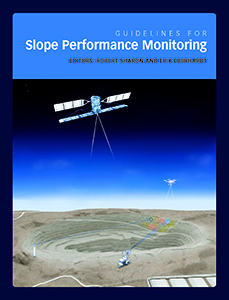A comprehensive and robust slope performance monitoring system is an essential component of the risk management program in an open pit mining operation. Local conditions and experience should drive the development of the monitoring program, and development of an early warning system. Consideration must also be given to available monitoring alternatives versus local operational requirements with a recognition that monitoring technology is changing rapidly. This requires serious effort to understand the capabilities and limitations of the instrumentation selected to ensure that the monitoring system is and remains effective and reliable.
Performance monitoring of open pit slopes is directed at safe and economic open pit development. Emphasis is placed on practical matters of operations support, including the human resources required to manage the monitoring system, including the appropriate skill-sets and continuing training requirements. For successful implementation, it is important to understand essential monitoring requirements of the mine site, including at least a basic understanding of potential failure mechanisms.
In compiling the book, the editors received invaluable input and assistance from the sponsors, industry practitioners, and equipment and software suppliers. The Preface and acknowledgements section at the front of the book is a feature worth examination.

Robert Sharon
Erik Eberhardt
Chapter Outlines
A Guidelines for Slope Performance Monitoring book contain 10 chapters as detailed below. Opportunities for improvement are evident from continuing advances made in instrument capability, data communications, speed, and integration of data that come from improvements in computing, and the ability to acquire data using remote methods that will continue to be required from the mine operators/owners. Innovation applied to the development of new instrumentation and remote monitoring, investigation, and problem solving will be driven by mine operators who seek to automate their operations and remove people from potentially hazardous conditions. Motivation for increasing automation of mining operations is driven by safety performance, economy (budgets and staffing), and risk management.
As mining operations evolve towards increasing automation, it is anticipated that geotechnical performance monitoring systems will also become increasingly automated. Data management, interpretation, and results reporting from instrumentation will also become increasingly automated. A primary goal of such a performance monitoring system will be to manage critical procedural controls in real-time that will maximise geomechanics risk management in the automated mining environment.
The contents of these guidelines follow the general process involved in establishing and operating a slope monitoring system for an open pit mine. General thoughts about avoiding unexpected geotechnical events are addressed with a practical example that includes nine aspects that should be considered when reviewing the effectiveness of the operation’s performance monitoring program.
This chapter summarizes the role of, and motivation for, slope monitoring in open pit mining operations. The history of pit slope monitoring is presented, including aspects of systems utilized in the 1960’s that led to improvements in geodetic survey monitoring and the development of radar for slope monitoring that led to other remote sensing methods. The observational approach to mining is introduced, which is completed with a summary of key components of an operation’s ground control management plan.
This chapter addresses surface, subsurface and space-based sensors, instruments and satellite systems commonly used for slope performance monitoring and how they work. Monitoring methods that include the value of visual inspections are addressed, as well as the importance of geodetic monitoring for data and results reliability and assurance quality.
addresses applications, monitoring system design and a compilation of the capabilities and limitations of key instrumentation used for slope performance monitoring. Other subjects include, utilizing a risk-based approach to rationalize monitoring system design, geo-referencing, integrated monitoring system design, monitoring for rockfall and bench-scale instability, and microseismic monitoring applied to open pits.
This chapter moves beyond the why, what and how of monitoring systems, with a focus on putting the principles and theories into practice in the typical mine environment. Consideration for instrumentation layout, protection and maintenance are described. The important subject of monitoring program staffing and organization, including skillset requirements, are described in detail.
The various methods of communicating data using hard-wired systems, WiFi and radio communications to satellite systems are described. Network requirements and limitations and cautions, and future developments are also described leading to data management and storage requirements. Data validation and reliability are described. Your Content Goes Here
This chapter describes what slope engineers can do to make the best use of data that is available to best understand slope performance (e.g. visualization (see also Chapter 10) and data integration for confirming reliability), assess the failure mechanism, identify risk areas, predict time to failure and provide relevant information for mine design and problem resolution.
This chapter where communication of slope monitoring results is vital to the practical use of data applied to geotechnical risk management that includes keeping people safe and protecting the operation’s assets (equipment, infrastructure and ore reserves). Observational mining is revisited, TARPs are defined and described as well as linkage to the operation’s emergency response program. The duty of care and external reporting of monitoring information is also addressed.
This chapter provides general descriptions of monitoring of related mine facilities, and reconciliation of monitoring data with the overall geotechnical program for the mine. Monitoring system design for small operations with limited budgets is addressed; and two detailed case histories are presented to describe details of integrated monitoring of infrastructure adjacent to a large open pit (Jwaneng in Botswana), and monitoring open pit highwall influences on the stability of an adjacent underground mine (Golden Sunlight in Montana).
This chapter presents suggestions for monitoring system design using a risk-based approach; and potential future developments, in particular related to automated mines in the future. A sampling of innovative geotechnical monitoring methods under development, some of which are still visionary, include:
- utilisation of microsensors (nano-sensors) for mine environmental and deformation monitoring;
- imaging spectroscopy using remote mapping methods;
- autonomous mapping, inspection, and analysis using fully autonomous UAVs; and
- virtual reality for open pit visualisation, inspection, and monitoring.


